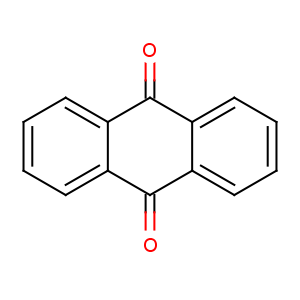Title: Anthraquinone
CAS Registry Number: 84-65-1
CAS Name: 9,10-Anthracenedione
Synonyms: 9,10-anthraquinone; 9,10-dioxoanthracene
Trademarks: Flight Control (DCV)
Molecular Formula: C14H8O2
Molecular Weight: 208.21
Percent Composition: C 80.76%, H 3.87%, O 15.37%
Literature References: Prepn: A. Laurent,
Ann. 34, 287 (1840). Structural relationship with anthracene: C. Graebe, C. Liebermann,
Ber. 2, 332 (1869). Industrial prepn from phthalic anydride and benzene: Klipstein,
Ind. Eng. Chem. 18, 1327 (1926). From anthracene with vanadium pentoxide, sodium chlorate, glacial acetic and sulfuric acids:
Org. Synth. coll. vol. II, 554 (1943). Convenient lab procedure: L. F. Fieser,
Organic Experiments (Heath & Co., Boston, 1964) pp 195-200. Review of chemistry: M. Phillips,
Chem. Rev. 6, 157 (1929); of manufacture and uses: A. J. Cofrancesco in
Kirk-Othmer Encyclopedia of Chemical Technology Vol. 2 (Wiley-Interscience, New York, 4th ed., 1992) pp 801-814. Development as bird repellent: R. M. Poché,
Proc. 18th Vertebr. Pest Conf. 1998, 338. Field trial to control Canadian geese: P. Devers
et al. ibid. 345.
Properties: Light yellow, slender monoclinic prisms by sublimation
in vacuo. Almost colorless, orthorhombic, bipyramidal crystals from H2SO4 + H2O. d420 1.42-1.44. mp 286°. bp760 377°. Absorption spectrum: Flexser
et al., J. Am. Chem. Soc. 57, 2103 (1935). Insol in water. Solubility (g/100 g) in alc at 18° 0.05; at 25° 0.44; in boiling alc 2.25; in ether at 25° 0.11; in chloroform at 20° 0.61; at 40° 1.00; at 60° 1.60; in benzene at 20° 0.26; at 40° 0.50; at 60° 1.00; at 80° 1.80; in toluene at 25° 0.30.
Melting point: mp 286°
Boiling point: bp760 377°
Density: d420 1.42-1.44
CAUTION: Low acute oral toxicity, but may cause skin irritation, sensitization.
See Clinical Toxicology of Commercial Products, R. E. Gosselin
et al., Eds. (Williams & Wilkins, Baltimore, 5th ed., 1984) Section II, p 189.
Use: Starting material for the manufacture of dyes; bird repellent.

